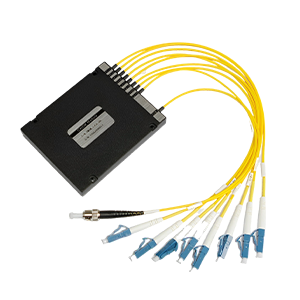I am pleased to introduce you to the GLC-LX-SMD optical module, a small module for optical fiber transmission with a wide range of applications. The GLC-LX-SMD optical module can convert optical signals into electrical signals, or electrical signals into optical signals, to achieve reliable data transmission. It uses a fiber wavelength of 1310 nanometers and is generally suitable for applications with transmission distances not exceeding 10 kilometers.
In data centers and enterprise networks, GLC-LX-SMD optical modules can be used for connections between servers, storage area networks (SAN), and inter-floor connections. Its small form factor makes it suitable for limited space and high-density fiber optic connection needs. The GLC-LX-SMD optical module has reliability and compatibility, ensures stable data transmission, and has broad future development prospects in fiber optic network expansion.
When using GLC-LX-SMD optical modules, please ensure correct fiber connections and network device configuration to achieve optimal performance. As the demand for high-speed transmission and optical fiber networks increases, GLC-LX-SMD optical modules will continue to develop to meet the changing needs.
Introduction to GLC-LX-SMD optical module
Definition and background:
GLC-LX-SMD optical module is a small optical module used for optical fiber transmission. It belongs to one of the series of optical modules produced by Cisco Systems and is used to implement optical fiber connections in Cisco network equipment. The GLC-LX-SMD optical module has an LC connector and provides a high-performance optical fiber transmission solution.
Transmission distance and wavelength:
GLC-LX-SMD optical modules are usually used for short to medium distance optical fiber transmission. It supports a maximum transmission distance of 10 kilometers (6.2 miles). The module uses a fiber wavelength of 1310 nanometers for transmission.
Fiber wavelength refers to the wavelength of optical signals when they are transmitted in optical fibers. For the GLC-LX-SMD optical module, the wavelength it uses is 1310 nanometers. This wavelength is in the infrared region of the visible spectrum and is invisible to the human eye.
The working principle of GLC-LX-SMD optical module
Photoelectric conversion:
GLC-LX-SMD optical module realizes mutual conversion between optical signals and electrical signals through photoelectric conversion. It contains a light transmitter and a light receiver.
The optical transmitter is located at the sending end of the optical module. It receives electrical signals and converts them into optical signals. Typical light emitters use semiconductor lasers (such as laser diodes), which generate a laser beam by injecting an electric current. The laser beam is coupled into the optical fiber and becomes an optical signal.
The optical receiver is located at the receiving end of the optical module. It receives optical signals and converts them into electrical signals. A typical light receiver uses a photodiode or photodetector, which converts a light signal into an electrical current. After the current is amplified and processed, it becomes a digital electrical signal for processing and transmission in network equipment.
Optical fiber transmission:
GLC-LX-SMD optical module transmits data through optical fiber. Optical fiber is a flexible, transparent material with a high refractive index that can transmit optical signals along its length.
When a light signal enters an optical fiber, it travels through the fiber’s core. The fiber’s core is made of a high-refractive index material (usually glass or plastic) and is surrounded by a low-refractive index material (the cladding). Due to the difference in refractive index between the core and the cladding layer, the optical signal undergoes total internal reflection inside the fiber, thereby maintaining the transmission of the optical signal.
The refraction and reflection processes of optical fibers enable optical signals to be transmitted in optical fibers while reducing signal loss and interference. This enables the GLC-LX-SMD optical module to provide reliable data transmission in fiber optic transmission.
Characteristics and performance of GLC-LX-SMD optical module
Transmission rate:
GLC-LX-SMD optical modules have high transmission rates, typically 1 gigabits per second (Gbps). It supports high-speed data transmission and is suitable for network applications requiring higher bandwidth. This enables the GLC-LX-SMD optical module to handle the transmission of large amounts of data and support high-performance network connections.
Transmission distance:
GLC-LX-SMD optical module has a long transmission distance, generally up to 10 kilometers (6.2 miles). This makes it suitable for network connection needs that cover a larger area. The long transmission distance of the GLC-LX-SMD optical module allows it to provide reliable data transmission on network links spanning longer distances.
Single mode fiber:
GLC-LX-SMD optical module uses single-mode fiber for optical transmission. Single-mode fiber has a smaller mode of light, allowing the beam to travel along the core of the fiber. In contrast, multimode fiber has larger light modes, resulting in a wider propagation mode of the beam. Using single-mode fiber can reduce the dispersion and loss of optical signals and provide more stable and reliable transmission performance.
The features and performance of the GLC-LX-SMD optical module make it a reliable fiber optic transmission solution. It has high transmission rate and long transmission distance, and is suitable for applications requiring large bandwidth and long-distance transmission. At the same time, by using single-mode fiber, it can provide narrower beam transmission characteristics, improving the stability and reliability of transmission.
Application fields of GLC-LX-SMD optical modules
data center:
GLC-LX-SMD optical modules are widely used in data centers. It can be used for connections between servers to achieve high-speed data transmission and communication. In data center networks, GLC-LX-SMD optical modules can connect servers, network switches, storage devices, etc., supporting high-bandwidth and low-latency data transmission requirements. In addition, it can also be used in storage area networks (SAN) for high-speed data transmission between storage devices, Fiber Channel, and hosts.
Corporate network:
GLC-LX-SMD optical modules are also widely used in enterprise networks. It can be used for inter-floor connections to achieve high-speed communication between different floors. Enterprise networks usually need to connect network equipment and servers distributed on different floors. GLC-LX-SMD optical modules can provide stable optical fiber transmission solutions to meet high bandwidth and long-distance transmission requirements.
In addition, GLC-LX-SMD optical modules can also be used to extend corporate networks to remote office locations. For remote office locations spanning longer distances, fiber optic transmission is an ideal solution, and the GLC-LX-SMD optical module can provide long-distance transmission and high-bandwidth support. It can connect the network equipment of remote branches and the network of the headquarters to achieve efficient remote office and data transmission.
Advantages and considerations of GLC-LX-SMD optical modules
Small package:
The GLC-LX-SMD optical module adopts a small package, making it suitable for limited space and high-density fiber connection requirements. In environments such as data centers and enterprise networks, space is often a precious resource, so compact optical modules are required. The small package of the GLC-LX-SMD optical module enables it to fit into these restricted spaces and allow for flexible deployment in high-density fiber connection environments.
Reliability and compatibility:
The GLC-LX-SMD optical module has high reliability and compatibility, ensuring stable data transmission. It undergoes strict testing and quality control to provide reliable performance in different working environments. In addition, GLC-LX-SMD optical modules generally comply with optical and electrical interface standards, such as IEEE 802.3 and optical fiber communication standards, and are compatible with other optical modules and network equipment. This ensures that the GLC-LX-SMD optical module integrates seamlessly with existing equipment and infrastructure, reduces compatibility issues, and provides reliable data transmission.
Other considerations:
In addition to the advantages, the following factors need to be considered when using GLC-LX-SMD optical modules:
-
Fiber type: GLC-LX-SMD optical module is suitable for single-mode fiber, so you need to ensure that the fiber type used matches the module for optimal performance and compatibility.
-
Environmental conditions: The operating performance of the GLC-LX-SMD optical module may be affected by environmental conditions, such as temperature, humidity, and vibration. When selecting and using optical modules, you need to consider the operating temperature range and other environmental conditions that suit the environment.
-
Optical fiber connection: When installing and connecting the GLC-LX-SMD optical module, you need to pay attention to the correct connection and installation of the optical fiber. The quality and stability of fiber optic connections are critical to ensuring reliable data transmission.
Deployment and configuration of GLC-LX-SMD optical module
Fiber optic connection:
When deploying GLC-LX-SMD optical modules, you need to pay attention to the following fiber connection requirements:
-
Connector type: GLC-LX-SMD optical module usually uses LC (Lucent Connector) type optical fiber connector. Therefore, make sure that the single-mode fiber using an LC connector matches the connector type of the optical module.
-
Fiber attenuation limitation: GLC-LX-SMD optical module will have a certain attenuation during fiber transmission. Ensure that the attenuation of the optical fiber used is limited within the specifications of the optical module to ensure good signal quality and transmission performance.
Network device configuration:
The deployment of GLC-LX-SMD optical modules usually requires the configuration of network devices such as switches and routers. The following are general network device configuration steps:
-
Confirm optical module support: Before configuration, ensure that the network device supports the GLC-LX-SMD optical module. Check the device’s specifications and documentation to confirm whether its optical module slot is compatible with GLC-LX-SMD.
-
Install the optical module: Insert the GLC-LX-SMD optical module into the optical module slot of the network device. Make sure it is inserted correctly and connected securely.
-
Configuration interface: Enter the configuration interface of the network device and find the interface related to the GLC-LX-SMD optical module. Configure the interface’s rate, duplex mode, and other related parameters according to the device’s configuration interface and command line interface. Make sure the interface matches the specifications of the optical module.
-
VLAN configuration (optional): If you need to connect the GLC-LX-SMD optical module to a specific virtual LAN (VLAN), you need to perform the corresponding VLAN configuration. This may involve the creation of VLANs, assignment of interfaces and related VLAN tagging settings.
-
Testing and verification: After completing the configuration, perform testing and verification to ensure the normal operation of the optical module. Optical link connectivity and performance can be checked using appropriate network testing tools.
Please note that specific network device configuration steps may vary depending on the device make, model, and operating system. It is recommended to refer to the documentation and operating manuals of your network devices for accurate configuration guidelines.
Summarize:
As a small module used for optical fiber transmission, GLC-LX-SMD optical module has many advantages and a wide range of applications. It uses the fiber wavelength of 1310 nanometers and is suitable for medium and short distance transmission needs. In data centers and enterprise networks, GLC-LX-SMD optical modules can be used for connections between servers, storage area networks (SAN), connections between floors, and expansion of remote office locations.
Its small package makes it adaptable to limited space and high-density optical fiber connection needs, while also providing reliability and compatibility to ensure stable data transmission. In the future, as the demand for high-speed transmission and optical fiber networks increases, GLC-LX-SMD optical modules will continue to develop to meet the requirements for higher bandwidth and longer transmission distances. I hope this article can help you better understand the GLC-LX-SMD optical module and achieve excellent results in practical applications.
- What is difference between GLC-LH-SMD and GLC-LH-SMD?
- What is the GLC-LH-SMD used for?
- What is GLC ZX SMD?
- What is GLC in SFP?
- What is GLC T module?
- What is GLC-SX-MMD used for?
- What is the difference between GLC LH SMD and GLC-SX-MMD?
- What is the difference between LX and SX fiber transceivers?
- What is the range of GLC ex SMD?
-
100G CFP ER4 1310nm 40km Transceiver Module
-
100G CFP LR4 1310nm 10km Transceiver Module
-
100G CFP2 ER4 1310nm 40km Transceiver Module
-
100G CFP2 LR4 1310nm 10km Transceiver Module
-
100G CFP2 ZR4 1310nm 80km Transceiver Module
-
100G QSFP28 1310nm 10km LC Transceiver Module
-
100G QSFP28 1310nm 10km Single Lambda Optical Transceiver
-
100G QSFP28 1310nm 500m Single Lambda Optical Transceiver
-
100G QSFP28 BIDI 1310nm 20km Transceiver Module



